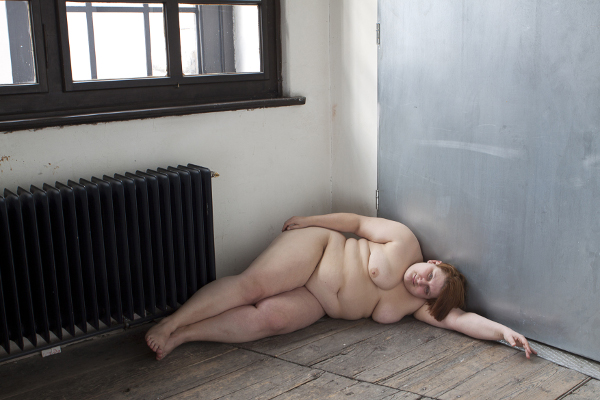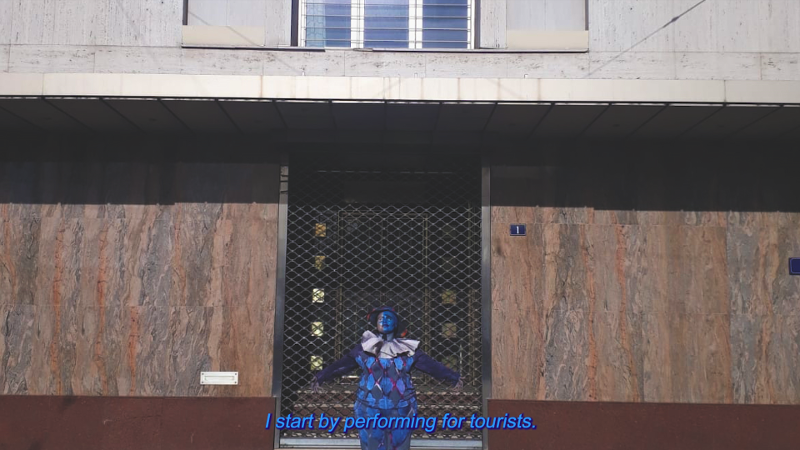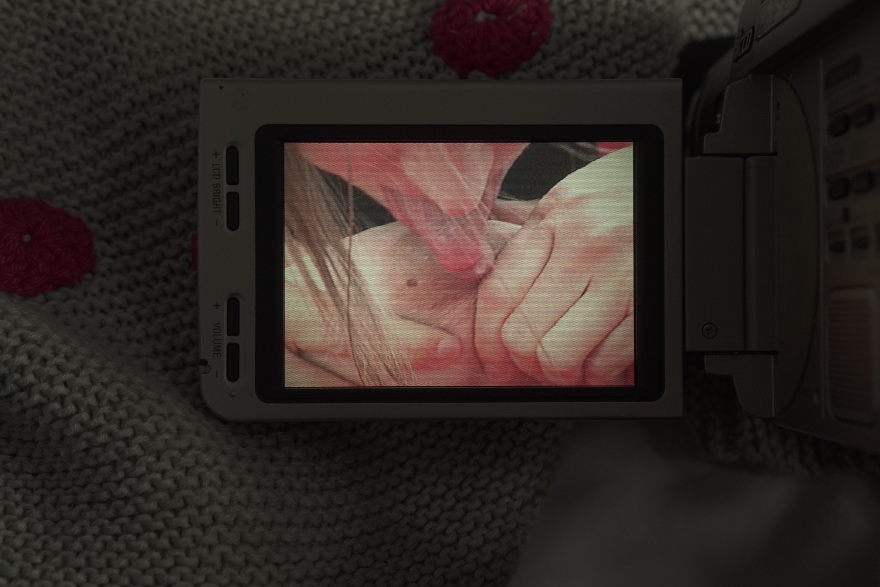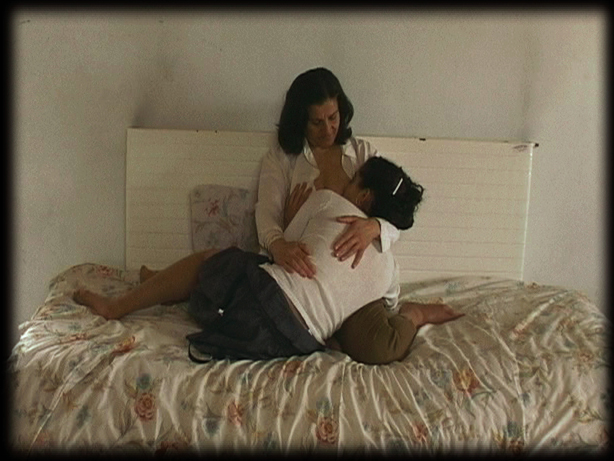dis/appearing subjects
curated by EVBG (Marie Sophie Beckmann & Julie Gaspard), Berlin
Disappearing in order to (re)appear, but differently and always anew: In the chapter "dis/appearing subjects" the artists Giulia Essyad and Anni Puolakka, in conversation with EVBG, investigate the means and conditions of (non)appearance in relation to (gender) identity, the capabilities and presence of the body, digital technology, and public space. In the process, roles are tried on and then shed again, bodies are subjected to multiple transformations, past experiences are revisited, and the question of where liberation is to be found is negotiated: in the moment of emergence or submergence? Or somewhere in between?
The Body Must Be Heard
(Excerpts From a Short Conversation on Big Questions)
curated by EVBG (Marie Sophie Beckmann & Julie Gaspard), Berlin
Disappearing in order to (re)appear, but differently and always anew: In the chapter "dis/appearing subjects" the artists Giulia Essyad and Anni Puolakka, in conversation with EVBG, investigate the means and conditions of (non)appearance in relation to (gender) identity, the capabilities and presence of the body, digital technology, and public space. In the process, roles are tried on and then shed again, bodies are subjected to multiple transformations, past experiences are revisited, and the question of where liberation is to be found is negotiated: in the moment of emergence or submergence? Or somewhere in between?
The Body Must Be Heard
(Excerpts From a Short Conversation on Big Questions)
The Body Must Be Heard
(Excerpts From a Short Conversation on Big Questions)
At the beginning of May 2022, EVBG met Anni Puolakka and Giulia Essyad on Zoom. Four squares appeared on each of our screens, windows into an office in northern Germany, a Berlin bedroom, an apartment in Geneva, and the couch of one artist's mother in Helsinki. The small moments of delay and interruption (a crashing computer, Zoom's 40-minute time limit, and a crying baby) that accompanied our conversation can also be taken as indicative of its main themes: First, the digital condition and how it affects the presentation and preservation of (feminist) performance art, and second, how daily life, with all its demands, contingencies, and various forms of care and labour, intrudes into creative processes and vice versa. The notion of appearance and disappearance, which frames our chapter, was not explicitly addressed, but it emerged again and again like an invisible thread guiding our exchange: which social and spatial conditions enable the embodied, performing subject to appear? Which roles cause it to disappear, and what triggers its transformation?
Our conversation begins with a confession –
Poetry is the cringy part of my practice
– that gets us right down to business. Is cringe, that involuntary wince, a sign that something has gone too far? When you pour your heart out a little too much, reveal too freely, open yourself up to the world a little too far?
Embarrassment is a kind of compass, like a voice saying what you should or maybe shouldn’t do
Or, on the contrary, is leaning into discomfort the precondition for creation, especially in performance art?
There are all these hormones at play when you’re on stage, like adrenaline, and it’s like: now I have to go all the way in. Maybe I will get embarrassed after. But that’s what I like about performing: I feel like I turn into someone else
Appearing to disappear, disappearing to reappear in a different guise, putting on a costume, acting out a "what if". In their respective works, and especially in the pieces created for re.act.feminism, Anni and Giulia explore bodily identities, roles, and attributions. Anni probes the new functions their body fulfills after becoming a parent, and how this new, overarching reality of being a nourisher and caregiver affects their artistic work both in terms of content and in very practical ways.
Feminist (performance) art has always dealt with the question of how to be an artist and also fulfill all these other roles. But this is a feminist art project so let’s see what I can do with the baby here with me. I want to produce art, but I realized that I have to accept that I have to do it differently now
Giulia revisits a performance in which she takes on the role of a street mime, basing her costume on the harlequin figure from Picasso's paintings. Muting her voice and limiting her actions, she communicates with her audience only through her gaze and the physicality of her body. Stepping into this role and adhering to an unfamiliar set of rules opened up a space for exploration about one's own presence and/or absence. In this sense, it was a conscious choice not to document the performance, and the footage she now has was fed to her by audience members and passersby. Unable to control the produced image herself, viewers offer her their interpretation of the act they are witnessing, and who the performing person is or could be, inscribing their gaze into this performance’s peculiar documents.
Performance is often either forgotten or it becomes a legend
What comes after the event? Does performance have to disappear in order to remain, to become history or even myth? The archiving, historicisation, and theorisation of performance go hand in hand with the question of what is left behind of an art form whose hallmark is its supposed singularity and impermanence. Looking at the rich history of (feminist) performance art, it becomes clear that the line between performance as a live event and its documentation (as what remains) is not easily drawn, especially since “the act of documenting an event as performance is [not only] what constitutes it as such” (Auslander, 5) but also what enables its future reception. And, as art historian Amelia Jones aptly put it, “while the experience of viewing a photograph and reading a text is clearly different from that of sitting in a small room watching an artist perform, neither has a privileged relationship to the historical ‘truth’ of the performance.” (Jones, 11)
When I think of the term “digital performance,” I think of performing on Social Media
... and smartphone snapshots, Instagram live videos, browsing through one's own archive. The boundaries between liveness, medium, and documentation become even more stretchable in the digital domain than they already are. All the more so when the production of a digital performance happens for an online archive that also tells a certain history of feminist performance art with its collection of documents, to which Anni's and Giulia's works are now added. How to relate to this history, which reverberates in more ways than one?
There’s something about feminist performance art that it seeps into life more than any other art form. There are some works that come to mind all the time in my daily life… Being experimental with your body as a female has been so fucking liberating in the past decades
Seemingly simple, or everyday actions were transformed into performance art, but performances also resonate in our daily actions. We reflect: Which works of the re.act.feminism archive have stuck in our minds? For Giulia, the power of Jakob Lena Knebl’s works lies in the way they present the everyday body as a “seat of love and genius,“ an observation that led her to “reflect on the boldness and wisdom one can acquire, being fat, and how hard that is to communicate to people who don’t have this same experience.“ What we also note: While some performances have stayed in our minds and haunted our thoughts, we seem to remember others with our bodies, for instance while banging a pot or handling scissors. In Anni’s case, Jumana Manna’s work Familiar has resonated for multiple reasons: “To me, it manifests so powerfully how individual lives are ephemeral – and what time does and means to us, to our relations. The work is emancipatory, resisting the taboo of adult breastfeeding, which is a subject in my own practice as well.“
Taking your boob out in public and breastfeeding must feel like performance art. Like, you have to take a deep breath and continue with your action no matter what the reactions are
Fucking liberating.
References:
Amelia Jones, “‘Presence’ in Absentia: Experiencing Performance as Documentation”, in: Art Journal, 56:4 (1997), pp. 11-18.
Philipp Auslander, “The Performativity of Performance Documentation”, in: PAJ: A Journal of Performance and Art, 28:3 (2006), pp. 1-10.
(Excerpts From a Short Conversation on Big Questions)
At the beginning of May 2022, EVBG met Anni Puolakka and Giulia Essyad on Zoom. Four squares appeared on each of our screens, windows into an office in northern Germany, a Berlin bedroom, an apartment in Geneva, and the couch of one artist's mother in Helsinki. The small moments of delay and interruption (a crashing computer, Zoom's 40-minute time limit, and a crying baby) that accompanied our conversation can also be taken as indicative of its main themes: First, the digital condition and how it affects the presentation and preservation of (feminist) performance art, and second, how daily life, with all its demands, contingencies, and various forms of care and labour, intrudes into creative processes and vice versa. The notion of appearance and disappearance, which frames our chapter, was not explicitly addressed, but it emerged again and again like an invisible thread guiding our exchange: which social and spatial conditions enable the embodied, performing subject to appear? Which roles cause it to disappear, and what triggers its transformation?
Our conversation begins with a confession –
Poetry is the cringy part of my practice
– that gets us right down to business. Is cringe, that involuntary wince, a sign that something has gone too far? When you pour your heart out a little too much, reveal too freely, open yourself up to the world a little too far?
Embarrassment is a kind of compass, like a voice saying what you should or maybe shouldn’t do
Or, on the contrary, is leaning into discomfort the precondition for creation, especially in performance art?
There are all these hormones at play when you’re on stage, like adrenaline, and it’s like: now I have to go all the way in. Maybe I will get embarrassed after. But that’s what I like about performing: I feel like I turn into someone else
Appearing to disappear, disappearing to reappear in a different guise, putting on a costume, acting out a "what if". In their respective works, and especially in the pieces created for re.act.feminism, Anni and Giulia explore bodily identities, roles, and attributions. Anni probes the new functions their body fulfills after becoming a parent, and how this new, overarching reality of being a nourisher and caregiver affects their artistic work both in terms of content and in very practical ways.
Feminist (performance) art has always dealt with the question of how to be an artist and also fulfill all these other roles. But this is a feminist art project so let’s see what I can do with the baby here with me. I want to produce art, but I realized that I have to accept that I have to do it differently now
Giulia revisits a performance in which she takes on the role of a street mime, basing her costume on the harlequin figure from Picasso's paintings. Muting her voice and limiting her actions, she communicates with her audience only through her gaze and the physicality of her body. Stepping into this role and adhering to an unfamiliar set of rules opened up a space for exploration about one's own presence and/or absence. In this sense, it was a conscious choice not to document the performance, and the footage she now has was fed to her by audience members and passersby. Unable to control the produced image herself, viewers offer her their interpretation of the act they are witnessing, and who the performing person is or could be, inscribing their gaze into this performance’s peculiar documents.
Performance is often either forgotten or it becomes a legend
What comes after the event? Does performance have to disappear in order to remain, to become history or even myth? The archiving, historicisation, and theorisation of performance go hand in hand with the question of what is left behind of an art form whose hallmark is its supposed singularity and impermanence. Looking at the rich history of (feminist) performance art, it becomes clear that the line between performance as a live event and its documentation (as what remains) is not easily drawn, especially since “the act of documenting an event as performance is [not only] what constitutes it as such” (Auslander, 5) but also what enables its future reception. And, as art historian Amelia Jones aptly put it, “while the experience of viewing a photograph and reading a text is clearly different from that of sitting in a small room watching an artist perform, neither has a privileged relationship to the historical ‘truth’ of the performance.” (Jones, 11)
When I think of the term “digital performance,” I think of performing on Social Media
... and smartphone snapshots, Instagram live videos, browsing through one's own archive. The boundaries between liveness, medium, and documentation become even more stretchable in the digital domain than they already are. All the more so when the production of a digital performance happens for an online archive that also tells a certain history of feminist performance art with its collection of documents, to which Anni's and Giulia's works are now added. How to relate to this history, which reverberates in more ways than one?
There’s something about feminist performance art that it seeps into life more than any other art form. There are some works that come to mind all the time in my daily life… Being experimental with your body as a female has been so fucking liberating in the past decades
Seemingly simple, or everyday actions were transformed into performance art, but performances also resonate in our daily actions. We reflect: Which works of the re.act.feminism archive have stuck in our minds? For Giulia, the power of Jakob Lena Knebl’s works lies in the way they present the everyday body as a “seat of love and genius,“ an observation that led her to “reflect on the boldness and wisdom one can acquire, being fat, and how hard that is to communicate to people who don’t have this same experience.“ What we also note: While some performances have stayed in our minds and haunted our thoughts, we seem to remember others with our bodies, for instance while banging a pot or handling scissors. In Anni’s case, Jumana Manna’s work Familiar has resonated for multiple reasons: “To me, it manifests so powerfully how individual lives are ephemeral – and what time does and means to us, to our relations. The work is emancipatory, resisting the taboo of adult breastfeeding, which is a subject in my own practice as well.“
Taking your boob out in public and breastfeeding must feel like performance art. Like, you have to take a deep breath and continue with your action no matter what the reactions are
Fucking liberating.
References:
Amelia Jones, “‘Presence’ in Absentia: Experiencing Performance as Documentation”, in: Art Journal, 56:4 (1997), pp. 11-18.
Philipp Auslander, “The Performativity of Performance Documentation”, in: PAJ: A Journal of Performance and Art, 28:3 (2006), pp. 1-10.



